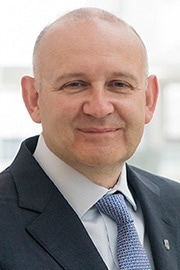As part of our SLAS Europe 2022 coverage, we speak to Professor Jeremy Simpson from University College Dublin about his lab's cell biology research and the role high-content screening can play in accelerating drug discovery.
Please could you introduce yourself and tell us what inspired your career into cell biology?
My name is Jeremy Simpson, and I am the Professor of Cell Biology at UCD. I was probably inspired along the way by several really important mentors: for instance, when I was doing my undergraduate degree, my mentor Professor Mike Lord was inspirational, and one of the things he taught me at the time in my undergraduate years was about the basic processes of how cells internalize material.
The reason why I was very excited about that, at the time, is because Michael Brown and Joseph Goldstein had just won the Nobel Prize for that work in the mid-1980s: which, for a young student like myself, suddenly being able to see that we can study cells and see how they take up materials was fascinating – and I think that set me on the course of being a cell biologist.

Image Credit: Elpisterra/Shutterstock.com
At University College Dublin, your laboratory utilizes high-throughput imaging technologies in a variety of life sciences disciplines. Can you describe some of the research that your lab is involved with?
In a way, that follows from the previous answer - one of the things that we are really interested in is how cells internalize materials, particularly how they internalize nanomaterials. We see huge prospects in functionalizing these nanomaterials in different ways to carry specific drugs and therapeutics.
As a cell biology and high throughput screening lab, we are trying to use the technologies to truly understand - in a systematic and high throughput manner - how all of these materials are brought into cells and where they are distributed into cells. So, for us, the technology part is a critical piece: it is bringing cell biology and technology together.
A large volume of your research is focused on the application of high-content screening. Can you tell us more about this technology and its role in drug discovery?
What we are trying to do here is simply make the most of the fact that when you look at a cell through the microscope, you can see all the different compartments, and all the different proteins doing whatever they do. The concept of high-content imaging and high-content screening is to use all that information. When we capture the images in the microscope, rather than just effectively saying, "Well, here's a nice picture, and this is what the cell looks like," we use high-content imaging technology to turn that into quantitative information. It can precisely describe what is going on in the cell in quantitative terms.
Of course, that is very powerful because it means that when we tweak something, change something a little bit, or for example internalize a different nanomaterial, we can precisely measure changes that are going on inside the cell. That is why I think this is a really exciting technology because, again, you can see how it can be applied. For example, if we have different therapeutics or drugs loaded onto different nanomaterials, we can assess how they interact with cells and elicit their effects.
We probably could not have even conceived of some of the experiments that we are doing now 10 or 15 years ago – partly because the technology was not there to be able to do the things that we do now. For us as a cell biology lab, I think it is essential to embrace the technology out there and use it to answer important questions.

Image Credit: paulista/Shutterstock.com
What are some of the advantages of using high-content screening for drug discovery compared to other technologies available?
We are capturing images of cells, and we are trying to use those images to answer specific biological questions. However, when you have the image, you effectively have a source of data that you can go back to repeatedly, and you can ask different questions. This means that one of the things we spend a lot of time doing in my lab is reanalyzing data from experiments and screens we have carried out in the past. You can extract different pieces of information by applying different software tools and algorithms.
In a way, that is the beauty of the technology: when you have gone to all of the trouble of creating the dataset and the images, it is not as though you harvest one piece of information and that is that done - which is, in a way, maybe what many of the other screening technologies are designed to do. With high-content imaging, you can keep extracting information in very different ways, months or even years, after doing those original experiments.
Given that imaging technology is costly, users want to maximize the amount of information they get at the end.
The drug discovery sector has seen significant advancements over recent years, but more is still needed to accelerate this process. What do you believe to be some of the biggest challenges currently faced by this sector?
I do think that there are still many challenges – although there have been significant developments over the last 10 and 20 years, in terms of technology enabling so many different things to happen in the life sciences sector.
One of the key emerging areas is artificial intelligence. Considering my own research, and thinking particularly of high-content imaging, we are extracting all this image data, but I believe there is much more we can get out of this. Again, we can go back to the images and examine these differently; we can use artificial intelligence to look much deeper into what is going on within the cells. Ultimately, I think this will be very powerful in the field of drug discovery and its associated technologies.
You are a keynote speaker at SLAS Europe 2022. What can people expect from your presentation?
One of the themes I am hoping to bring to the meeting is an underlining of the importance of fundamental science and fundamental research and how it underpins all of the other exciting applied work that is taking place.
Many of the exhibitors here at the meeting are interested in the next generation of drugs and how they target certain diseases. If we are going to understand those diseases and better understand how to design and develop new drugs, we have to get the basics right – so that is what I will focus on during my keynote.
I want to give some perspective on the challenges of trying to understand basic cell function and the broader work of what a cell biology lab has to offer the fields of drug design and drug delivery. Understanding basic cell function and how the fundamental knowledge that we gain from our experiments has the potential to be exploited 5 or 10 years down the line, for the next generations of drugs that will ultimately be developed. This is very much approaching the problem of identifying drugs and targets from a fundamental cell biology point of view and the contribution that we can make.
I think anybody who works primarily in applied or clinical research would recognize that their work is based on fundamentals that might have been undertaken 5, 10, or even 15 years earlier. In the life sciences sector, if we are going to maintain a pipeline of drugs into the future, we have also have to keep the start of the pipeline working well and ensure that fundamental science is still being performed.

Image Credit: metamorworks/Shutterstock.com
Nanotechnology has the potential to transform many sectors within life sciences. How could the implementation of nanotechnology, such as nanoparticles as therapeutic delivery vehicles, particularly excel the drug discovery sector?
The life science sector has been good at identifying new compounds – even different classes of drugs. One of the fundamental problems we face is how to deliver them more precisely into the body. In a way, I think this is where nanotechnology has the potential to play a big part.
The beauty of nanotechnology is that it allows us to, in principle, take any drug, any therapeutic, for example a small molecule, a nucleic acid, an antibody, or a protein-based therapeutic, and couple it to a nanomaterial.
On that nanomaterial, we have absolute control of elements like the charge, size, shape, and other targeting information, thereby providing it with exquisite specificity when it is put into the body.
This targeting can occur at the level of specific tissues or organs in the body and potentially to particular cell types within those tissues. Ultimately – which is where my research comes in – we should be able to target specific subcellular locations within individual cells. I believe that in the future, such potential will be incredibly powerful: this means that therapeutics that we may know work but which have not been able to be so precisely delivered, can now be converted into 'magic bullets'. This concept has existed for decades, but nanotechnology now provides a realistic opportunity for this to become reality.
This is where the whole field is exciting: it is not just one discipline alone that will solve things. In my lab, for instance, although we are a cell biology lab, we spend a lot of time working with our colleagues in chemistry because they are the experts on the design and synthesis of some of these new nanomaterials that we like to work with. It is very much in marrying different disciplines that ultimately solves the problems.
Your UCD Cell Screening Laboratory, as well as carrying out research, offers technical support for collaborators wishing to access your high-content screening platform. How important is this level of collaboration and support to drug discovery and life sciences research?
We see this as very much a two-way street. We established the lab approximately 13 years ago, and the concept was to have a single place within Ireland with high-content expertise and equipment that could potentially serve many people. The infrastructure is extremely expensive: robotics, automation, imaging, etc. Particularly in a small country like Ireland, you do not need to replicate such facilities across multiple locations. You need to have one place where that infrastructure is consolidated, and then, alongside that infrastructure, you need to have appropriate support so that you make the most of that investment.
This is the ethos with which we have positioned our lab. While we utilize the infrastructure for our own research and projects, at the same time we have researchers from all over the country who also access it. This means that these external users get the benefit of our expertise to be able to do the experiments they want to do.
We can advise on the best way to carry out a screen or an assay – and at the same time, we get something back, as we get to hear about the broader landscape within the country. For example, what diseases are being worked on; or what the drug discovery or delivery problems are being tackled elsewhere. This allows us to get a good sense of the landscape in that respect, and we learn from each other.
I also think that the beauty of research is that it guides itself, based on the conversations and interactions that researchers have.
Our experience is that in those serendipitous conversations, creativity flows, and brilliant ideas come from there. This is particularly so for a lab like ours that is based on a technology platform that can serve many different applications. When we get researchers visiting the lab who are working in very different fields of biology, they might come over and suggest something in a such a way where I might think: "Well, actually, I never thought of that." That then feeds into new ideas; all coming from the power of bringing people together.
Do you believe that if we modeled the same level of global collaboration we observed from the COVID-19 pandemic, we would see new therapeutics being bought to market faster? What would this mean for global health?
While we often reflect on the pandemic and all its natural negatives and lows, I have to acknowledge that there have been incredible positives as well: in the global response, the development of vaccines, and the repurposing of therapeutics.
Perhaps nobody appreciated how fast that work could be done when there was an absolute necessity. Again, I think that has challenged a lot of the conventions that state that the process of developing a therapeutic has to take ten years.
We have been able to demonstrate through the pandemic that if you can bring the right people together, adding in industry, academic expertise, technology and technology platforms - with some urgency – the life sciences sector can respond quickly. Perhaps the pandemic has been a wake-up call in that respect: a reminder that we should try and bring these groups together more often and more intensely to address other significant problems in health and disease.
This all circles back to the fact that all of the applied research that is going on is all underpinned by fundamental research that is often going on in research institutes and universities: it is really about keeping that pipeline of really high-quality fundamental research coming through, to ensure that when we do need to respond to a pandemic or health emergency, everything is in place to be able to react quickly.
Throughout your career, what has been your proudest achievement?
It is tough to pin it down to one individual moment. The thing that makes me proudest year-in, year-out is when the students come through my lab, are successful in their work, and then use their success to advance into the next phase of their career.
I love being an integral part of the pipeline of people developing in their scientific careers. That always fills me with immense pride: that students come to my lab, learn how technology can be applied in cell biology, and then they are able to walk into the next position, or the next job, and make their own impact. For me, playing a small part in that is satisfying every single time.

Image Credit: fongbeerredhot/Shutterstock.com
What's next for you in your research team? Are there any inspiring research projects upcoming that you're involved in?
There is a big push toward working with more advanced cell models in my lab. We think that they are important for understanding several human diseases. Such models are also important for understanding and improving drug delivery, which is one of the core focuses of my lab.
One of the things that we have done in the last three or four years is switch from doing conventional cell-based assays in monolayer cultures into more advanced, three-dimensional cell models. They are much more difficult to work with, particularly for a high-content imaging lab: imaging and then quantitatively analyzing these three-dimensional structures is incredibly challenging.
We recognize, however, that this is the future - we need the in vitro models we are working with to much closer resemble the in vivo situation. Throughout the last few years, we have been using several spheroid models and we are just starting to work with organoids. We are also doing some work with explants: much more challenging again, but these are systems that are realistic. Over the next couple of years, we plan to see if we can combine some of the high-throughput and automation experiments we have traditionally done in monolayer culture systems and use those in these 3D, more complex models.
When applying high-content screening to 3D cell models then one of the biggest challenges we will deal with is data. These experiments generate tens to hundreds of terabytes of experimental data – but I am confident that we will work out ways to handle these massive datasets.
Where can readers find more information?
To keep up to date with the UCD Cell Screening Lab's latest research, click here!
About Professor Jeremy Simpson
Jeremy Simpson holds a First Class BSc (Hons) degree in Microbiology & Microbial Technology (1992) and a PhD in Biochemistry & Molecular Biology (1996), both from the University of Warwick, UK. He spent post-doctoral time at the Scripps Research Institute (San Diego, USA) and the Imperial Cancer Research Fund (London, UK), before securing an EMBO Long-term Fellowship to join the European Molecular Biology Laboratory (EMBL) (Heidelberg, Germany) in 1999. He spent nine years at EMBL pioneering automated screening and microscopy approaches to study aspects of human cell behaviour.
He joined UCD in 2008, appointed as the Full Professor of Cell Biology, and established the UCD Cell Screening Laboratory. Since that time he developed and coordinated the MSc in Imaging & Microscopy programme (2010-2016) and was Head of Subject for the BSc Cell & Molecular Biology programme (2012-2020). He served a five and a half year term as Head of the School of Biology & Environmental Science (2014-2019), during which time he introduced a new MSc programme in the School, developed the School Advisory Board as a means to ensure fairer representation across the School, and led the School’s successful application for its Athena SWAN Bronze award. Between 2011 and 2021 he also held the role of Vice Principal International for the College of Science, transforming the international reputation of UCD Science globally and overseeing a significant growth of international students studying programmes in UCD Science. In 2021 he was appointed as the College Principal and Dean of Science for the UCD College of Science.
He is a Fellow of the UCD Conway Institute of Biomolecular & Biomedical Research, and is an active Editor of three international scientific journals. His research interests are focused on the organisation of mammalian cells, nanoparticle-mediated drug delivery mechanisms, and advanced imaging of 3D cell models as used to study human disease. He is the author of more than 120 peer-reviewed articles, including work published in Nature Cell Biology and Nature Methods.